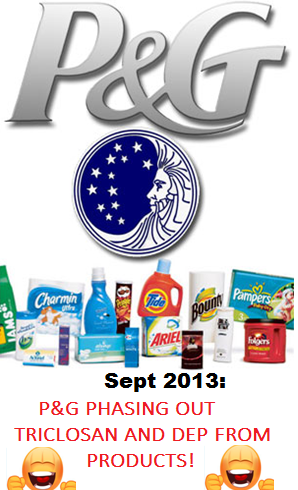Seems like every product on the market today has an “antibacterial” claim, as if we are all trying to fight the flu (or a runny nose) like the plague. However, did you ever think these antibacterial chemicals were being put in your toothpaste?! I sure didn’t!
What Is Triclosan?
What makes a product “antibacterial” is the active ingredient called triclosan. Triclosan can often be referred to as “Mircoban” (tradename). Considering the extent to which it is being use today (antibacterial liquid soap bars, toot pastes, deodorants and moisturizers) it can be problematic. I mean it is even in towels and hair accessories!
Why does everything in our culture have to be in such excess? I wish there was an extent (percentage) to the amount of products these chemicals could be allowed in our products.
Why Is Triclosan Harmful?
According to Health Canada, “anti-bacterial soaps/toothpastes are not recommended because they destroy good bacteria as well as bad, and can add to the problem of “antibiotic resistance.” Translation: they breed superbugs. Also it is important to note that colds and the flu are caused by viruses and antibacterial’s don’t work on viruses! In a nutshell, the main reason why we are washing with antibacterial soaps come cold/flu season is, simply, MARKETING.
Triclosan in Toothpaste
Many of you are concerned about triclosan in your toothpaste. It has been put in only certain toothpastes (*cough*, *cough* – Colgate Total Toothpaste). The main reason triclosan is there is to fight plaque, however scientist find that triclosan only offers minimal plaque inhibitory properties. However, there are other toothpastes out there like Crest Pro Health which have other antibacterial ingredients (i.e stannous fluoride), which are just as good as triclosan but don’t increase your risk of antibacterial resistance.

Triclosan Banned In Europe – But Not USA or CAN
The European Union and other countries have banned or restricted triclosan. Still, the federal Food and Drug Administration (FDA) says it is investigating the health issues, but doesn’t yet have enough evidence to recommend changing consumer use of products that contain triclosan.
At the same time, the FDA says it has no proof that washing with soap containing triclosan is actually better than washing with regular soap. The FDA advises that if you are concerned about using hand and body soaps with triclosan, you should wash with regular soap. To get the same effect, just wash your hands for 20 seconds (pretty simple solution -without all the chemicals).
Triclosan In Our Bodies
As a result of Health Canada and the FDA, not banning triclosan the level in our bodies are rising. For example, since 2004 the level of antibacterial triclosan coursing through our bodies has jumped by 50%.
Progress In Canada To Ban Triclosan
Fortunately, in 2009, none other than the Canadian Medical Association asked the feds to ban it from consumer products and a decision should be made soon.
So until triclosan is banned from your toothpaste and antibacterial products, try to limit your use and opt for a healthier option (i.e. regular soap, natural toothpaste or crest).
Alternative Options To Triclosan Toothpaste
Have no fear! You can buy toothpaste without triclosan (note: Nature’s Emporium – refer to link at top of blog, has a variety of options you can choose from). Regular Colgate doesn’t have it, but Colgate Total toothpaste does, and Tom’s of Maine sells many triclosan-free options. Crest Pro-Health toothpaste contains another antibacterial, stannous fluoride, also to help protect against gingivitis.
To learn more about triclosan in dish soap, refer to an earlier article. Also, here is what the FDA has to say about triclosan.



